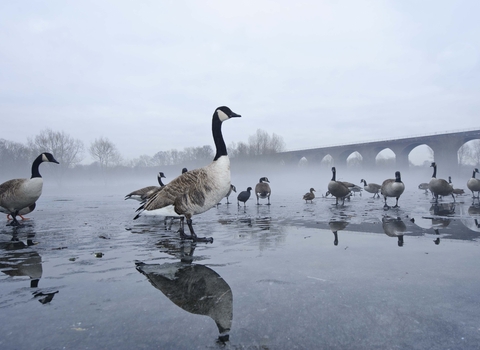
Canada geese © Terry Whittaker/2020VISION
Canada goose
The Canada goose is our most familiar goose, although it is not actually native to the UK. A common and bold bird, it can be found around most parks, lakes, reservoirs and gravel pits.
Scientific name
Branta canadensisWhen to see
January to DecemberSpecies information
Category
Statistics
Length: 55-100cmWingspan: 1.6m
Weight: 4.6kg
Average lifespan: 6 years
Introduced, non-native species. Common. Protected in the UK under the Wildlife and Countryside Act, 1981.
About
The Canada goose is our largest goose and maybe our most familiar. They are a common bird across most of the country, nesting on park lakes, flooded gravel pits and reservoirs. Canada geese are not native to this country, having been introduced from North America about 300 years ago. After the Second World War, they spread across the UK. Occasionally, wild Canada geese go astray and reach the UK from North America. These are usually single birds mixed in with flocks of barnacle or pink-footed geese, often found in northeast England and Scotland. Most confirmed records involve smaller subspecies of Canada goose, as ruling out feral birds is a challenge with sightings of the larger subspecies that is resident in the UK.How to identify
The Canada goose is a large goose, with a black neck and head, grey-brown back and white cheek patches.Distribution
Found almost throughout the country, except in the north of Scotland.Did you know?
Canada geese were first introduced to the UK in St. James's Park, London, in the 17th century. Today, the population is over 150,000 birdsWatch
Canada Goose (https://vimeo.com/444194326)
Canada Goose by John Bridges
